People continue to try comic binding because it liberates them from waiting for collected releases that may never materialize. With comic binding, your binds have the comics you want in the order you want them in. And without the publishing red tape that’s strangled so many awesome books in the past. What am I talking about? Follow me on this:
Let’s say I ask DC Comics to include the Batman/The Spirit oneshot from 2006 in their next Batman anthology collection and, miracle of miracles, they actually think about it. Had this been prior to 2014, no problem. DC held publishing rights to both Batman and The Spirit back then. But here in 2019 and beyond, the rights to The Spirit are held by Dynamite Entertainment. DC can only include that comic with permission from Dynamite, permission likely contingent on DC paying a royalty fee. That fee gets tacked on DC’s production cost for said anthology book, and possibly bumps it beyond what DC is willing to spend. Therefore, no Batman/The Spirit reprinted in any Batman anthology. *sad trombone*
Comic binding lets fans give that mashuganas the middle finger.
Freedom of content is a bedrock concept for comics binding and one of Shelf Bound‘s driving themes. Technically last month’s Comics 101 bind combined material from several publishers, but I think today’s bind will show off binding’s advantages in this area AND showcase one of my all-time favorite cartoonists at the same time: Darwyn Cooke.
(A slight digression before we continue:
This past Saturday would have been Cooke’s 57th birthday. As I take this column to show or remind you how good a cartoonist he was, it’s also important to remember the type of guy he was. And to me, he seemed like the best kind of Canadian tough-guy: sweet, sincere, polite, but ready to stand up or throw down if he saw someone in need. I’d like to offer this anecdote involving Josh Fialkov I included for Cooke’s passing back in May 2016. Cooke’s generosity always stuck with me as much as his storytelling, and the industry has been a lesser place these past three years for missing both.)
In comics, the first thing we see from an artist is usually what sticks with us. Human nature makes first impressions the hardest to get past; call it typecasting, pigeonholing, or what-have-you. But for working artists, it has to be frustrating to continually find editors and potential employers making decisions about whether or not to even consider you for a job based solely on that first impression of your work.
Like Darwyn Cooke.
Cooke’s default style and storytelling approach put him on the Bruce Timm/Alex Toth end of the comics spectrum. His figures looked a certain way, his designs avoided excess filigree for more streamlined approaches, and his storytelling eschewed obvious flash for subliminally rock-solid choices. Within those broad parameters, Cooke still presented work with varied flavors and textures when given the chance to show that versatility. Which, ultimately, was not as much as he wanted or deserved.
Readers `first impression’ of Cooke came from two books: Batman: Ego in 2000 and DC: The New Frontier in 2004. Ego found Bruce Wayne having an almost Dickensian come-to-Jesus moment with the spirit of his Batman alter ego. It wasn’t set in the Bruce Timm-styled DC Animated Universe and pushed a few boundaries the TV shows avoided, but the story leaned heavily into the visual vocabulary Cooke no doubt picked up from his time at Warner Brothers Animation. Ego tagged Cooke with the `cartoony artist’ label.

New Frontier showcased the Silver Age DC heroes in all their glory over six double-sized issues, against the backdrop of the 1960’s time period their comics originally appeared on newsstands. Cooke’s work always gets labeled as throwback, nostalgic, and retro because he could evoke the feel and vibe of that post-WWII American cool with such authority you’d think he lived through it with a drink in one hand and pencil in the other. New Frontier married that approach with Silver Age superheroes so strongly Cooke never quite shook its grasp.
In interviews, Cooke talked about those projects making it so much harder for him to do any other kind of work:
Continued below“If you end up good at something, then that’s what you do, that’s who you are,” Cooke said. “You tend to get typecast. I’m not bitching about that. I feel very lucky. You tend not to get offered work unless it’s something you’ve done before. DC never calls me up to do anything different. They call me up when they need a Silver Age riff or an old-timey thing. Other than that, I get offered crime work.”
This month’s bind is a Cooke monograph because I want a book to put in people’s hands when they say Cooke was just a ‘cartoony’ artist or someone stuck in the Silver Age. Something that let’s them know what we had while he was here, and we are missing now that he’s gone.
MAKING THE CUT
Here are my operating parameters:
1) The book’s final page count can’t be more than 576 pages.
The 576-page limit keeps things within the parameters of what can comfortably go into a single bound book. 24 issues at 24 pages/issue equals 576 pages.
2) Only Cooke-drawn material will be considered.
I like the material Cooke wrote for other artists (especially his Silk Spectre mini with Amanda Conner), but to pack as much Darwyn into this book as I can I’m ignoring the comics he only scripted.
3) As much style variety as possible.
Catwoman #1 wasn’t something I would have kept on it’s own, being the first part of a 4-part story and the less compelling of the other Selina Kyle stuff included. But it’s a decent setup issue and, more importantly, has Mike Allred’s inks giving Cooke’s work a sheen we don’t really see anywhere else in the book, so it stays. Issues #2 through #4 are jettisoned for space.
4) Represent as many publishers represented as possible.
Binds are anti-silo, remember?
Here’s what I came up with:
(All examples written & drawn by Darwyn Cooke unless otherwise noted)
Solo #5
(48 pages)
Solo was DC series edited by Mark Chiarello where he turned over 48 pages to a single cartoonist to do with as they pleased. Other issues showcased creators like Richard Corben, Daimon Scott, Tim Sale, Howard Chaykin, and Mike Allred, but issue #5 was Cooke’s turn. He knew this was a rare opportunity, so he took the title literally and did every story himself: writing, penciling, inking, and coloring. Solo #5 is essentially a template for this book as a whole, so it’s only fitting to lead off with it.
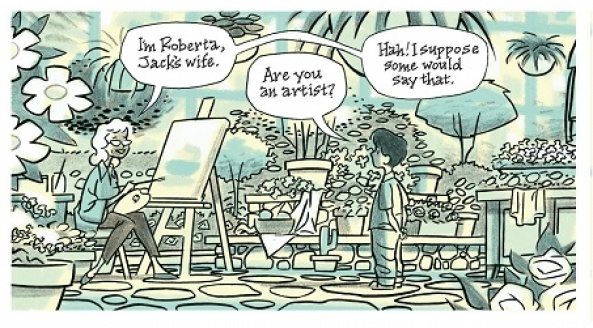


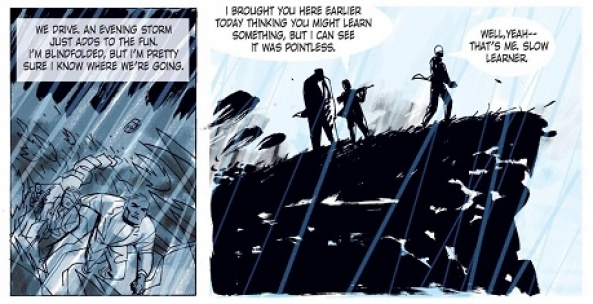
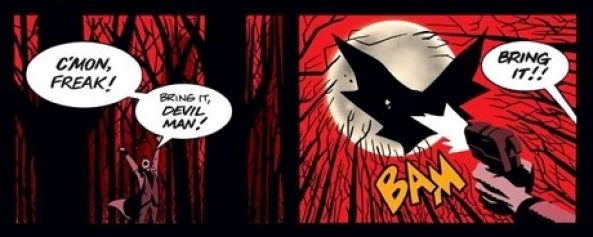
The issue’s framing device features one of Cooke’s on-page surrogates at his favorite DC bar, Jimmy’s 24/7. The last page ends with a nice little sendoff that sets up the rest of the book too well for me to not end with it:

Slam Bradley: On The Trail of Catwoman | Selina’s Big Score | Catwoman (v3) #1
(152 pages / 200 pages total)
Fans default to Cooke’s Batwork, but I always thought his (and Ed Brubaker’s) handling of Selina Kyle was a, if not THE, definitive take on the character. These stories were the first time I ever felt Selina had real agency beyond being a Batman supporting character. They also introduced me to the greatness of Slam Bradley, so bonus there.
These three comics give us three different configurations of Cooke’s Cat-work. Trail originally appeared as 8-page back-ups in Detective Comics and you see Cooke trying to cram as much on each page as possible (and Sean Konot’s typewriter font for Bradley’s hardboiled narration is a neat touch). Selina’s Big Score moves away from Gotham’s concrete box canyons and goes international. Cooke switches over to expansive and expressive, brushy and kinetic, while still keeping a throughline from Trail to Selina’s forthcoming series. I could go on all day about it. Finally, the Catwoman issue casts off the earlier experimentation for a more streamlined, mainstream Bat-look, albeit with that Allred sleekness I mentioned earlier.
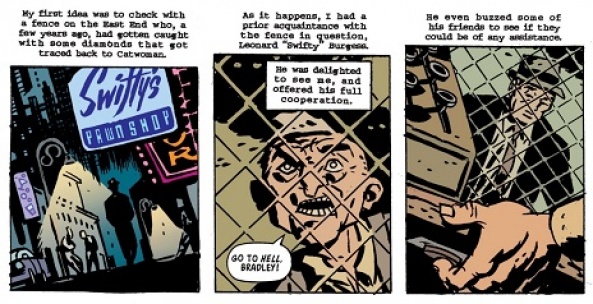
Script by Ed Brubaker, colors by Matt Hollingsworth, letters by Sean Konot.

Colors by Matt Hollingsworth.
Continued below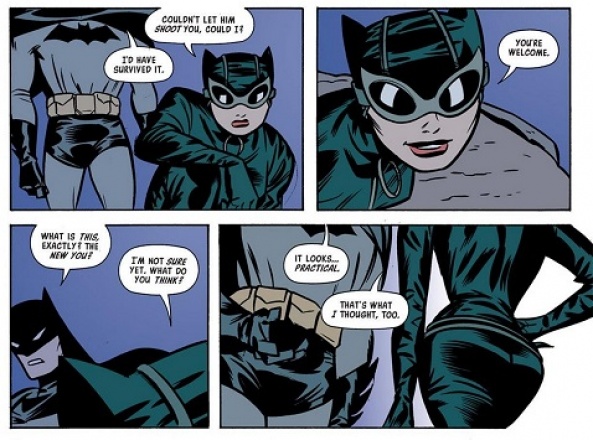
Script by Ed Brubaker, inks by Mike Allred, colors by Matt Hollingsworth, letters by Sean Konot.
Spider-Man’s Tangled Web #21
(48 pages / 248 pages total)
Time to turn on some light! We make a beeline from Gotham to Lee & Kirby’s New York with this Christmas story from Spider-Man’s anthology title. Lots of Marvel cameo’s in this one. Cooke really leans into the Kirby on this, and inker Jay Bone ups the playfulness factor with his `big foot’ inking style, making this story a real hoot. It’s a shame we didn’t get to see Cooke work with Marvel more, but understandable given the publisher’s handling of his Marvel Adventures proposal:
“Marvel solicited me to develop that line for them, and I did. I put together a business plan, the line of books, I brought in the other guys. I have so much artwork at home, you would not believe it. They took it all, they said this is fantastic, this is amazing, this is a home run, and then they never called me again. They handed it off to a bunch of other guys. That was the end of my relationship with Marvel. As long as Marvel is who it is right now, I can’t work for them.”
The only drawback with including both of Cooke’s Tangled Web stories is their length; at 48 pages a pop, they eat up page count real estate. So only one story in this book.

Inks by J. Bone, colors by Matt Hollingsworth.
X-Force #124 | X-Statix #1 | Woverine/Doop #1-2
(78 pages / 326 pages total)
More Merry Marvel Mayhem! Cooke namechecked Peter Milligan as a writer plugged into the type of stories and storytelling he enjoyed working on, and you can see the results of their pairing here. It’s a shame we didn’t get more comics from them because these three are fantastic.
Set inside the larger Allred/Milligan X-Force narrative and swinging from tender to zany to Blair Witch-esque horror, these comics are as effective at capturing that series take on mutants in pop culture as the regular issues were. The shaky-cam POV back-up from X-Statix #1, “Code-X”, is still one of the creepiest comics I’ve ever read. And I’m a Corben fan.
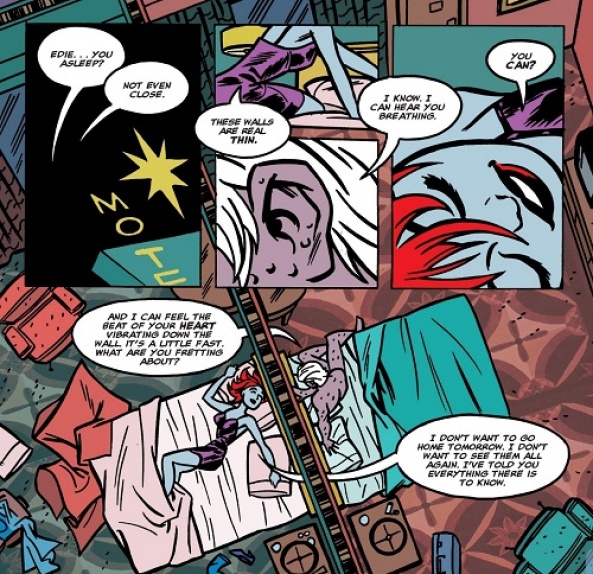
Script by Peter Milligan, colors by Laura Allred, letters by Blambot.

Script by Peter Milligan, colors by Laura Allred, letters by Blambot.

Script by Peter Milligan, inks by J. Bone, colors by Laura Allred, letters by Blambot.
Before Watchmen: Minutemen #6
(28 pages / 354 pages total)
That’s right. There’s a Before Watchmen issue here. Divorced from the hype and backlash and questions about its necessity, the actual Minutemen comic Cooke created is pretty good. He turned down DiDio’s offers for TWO YEARS before finally the light bulb finally went off and he put pencil to paper. It doesn’t do any damage to the Gibbons/Moore original book, it’s solid comic booking, and I wanted it represented. My only question was which issue: I went back & forth over whether to include issue #1 or #6, finally going with #6. But YMMV.

Colors by Phil Noto, letters by Jared K. Fletcher.
Will Eisner’s The Spirit #1, #8
(64 pages / 418 pages total)
The closest we ever came to a Cooke ongoing series. It’s an absolute crime this series, with Cooke writing & drawing 11 of the first 12 issues, isn’t currently in print. As I mentioned above, DC lost the license to Dynamite a few years ago, but Dynamite hasn’t put it back in print either. Maybe that Batman/Spirit one-shot problem cuts both ways? I dunno.
Why pick these two issues? I wanted self-contained stories without leaning on Batman material or heavily-Eisner-referenced issues. Issues #9-11 are one big story, #12 homages an earlier Eisner story, #3 sets up #9-11, and #7 is a non-Cooke issue. The first issue establishes Cooke’s take on The Spirit really well, and #8 is a nice one-and-done.
And I do recognize the irony of making such an example with Batman/The Spirit and NOT including it in the final book.
Continued below
Colors by Dave Stewart, letters by Jared K. Fletcher.

Inks by J. Bone, colors by Dave Stewart, letters by Jared K. Fletcher.
Excerpts from Creator-Owned Heroes #6-8
(12 pages / 430 pages total)
A really great idea from Jimmy Palmiotti, Steve Niles, and company via Image Comics that just didn’t make it to an audience. Where comic books met comic magazines, each 40-page regular-sized comic gave you two comics stories, an interview, and some additional material. Cooke used his pages to showcase three short 4-page strips done for other outlets, including one done as a wedding gift. Bring a hanky.


Excerpts from DC: The New Frontier
(48 pages / 478 pages total)
“Hey! Where’s New Frontier???? Ya can’t have a Cooke book without New Frontier!”
Well, pilgrim, I almost did. Cooke certainly gave readers their money’s worth with 48-page issues, but those are space-guzzlers, and I couldn’t find an issue I thought captured everything I wanted enough to justify the page cost. Even using the New Frontier Special‘s 24-page story didn’t cut it for me (I can see why it got cut from the original narrative in the first place, well-executed though it was).
Then it hit me that Cooke structured the original issues as chapters, so I’m blocking out 48 pages here to pull in material, such as the “NewsTime” chapter from issue #1 or the Steel story pages, from various issues.

Colors by Dave Stewart, letters by Jared K. Fletcher.
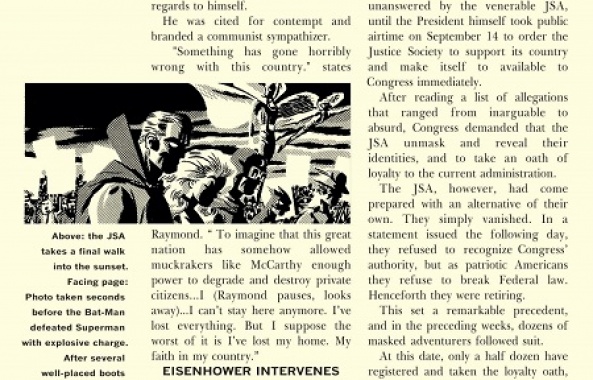
Colors by Dave Stewart, letters by Jared K. Fletcher.

Colors by Dave Stewart, letters by Jared K. Fletcher.
Parker: The Man With The Getaway Face
(24 pages / 502 pages total)
I might have gotten away with skipping New Frontier, and I did skip Batman: Ego, but I couldn’t bring myself to do a Cooke book without Parker. Thankfully, IDW releasing this standalone prologue to Cooke’s The Score adaptation gives me a nice manageable chunk of Parker material to include.
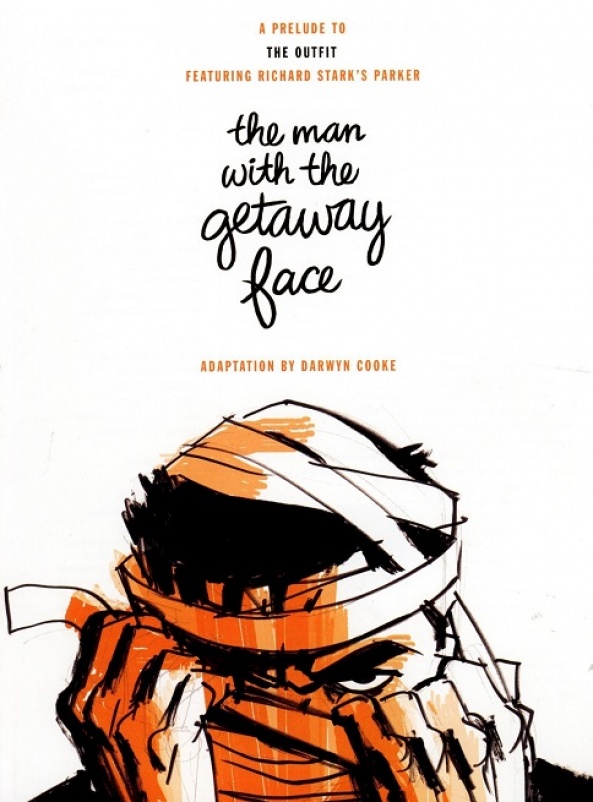

Jonah Hex #33, #50 | All-Star Western #34
(72 pages / 574 pages total)
Jimmy Palmiotti wasn’t just one of Cooke’s closest friends, he was also one of his best collaborators. These Hex stories the two worked on (with co-writer Justin Gray) are fantastic, and give Cooke an opportunity to put down the Batarang and pick up a six-shooter. The second and third issues pick up a little bit of Jonah Hex series continuity with Palmiotti/Gray/Noto creation Tallulah Black, but are still able to be read and enjoyed in this context.
It might just be me, but you can see Cooke pushing his style into Jean Giraud/”Blueberry” territory on some of these issues, rendering some some extra-fine line detailing not out-of-place in that Western setting. For more of that style malleability, check out his “Flight” story from Green Lantern Secret Files to showcase him evoking Gil Kane and Neal Adams something fierce while still staying in his overall voice.

Script by Jimmy Palmiotti & Justin Gray, colors by Dave Stewart, letters by Rob Leigh.

Script by Jimmy Palmiotti & Justin Gray, colors by Dave Stewart, letters by Rob Leigh.
PUTTING IT TOGETHER
Now that we’ve got our list of ingredients (or you’ve compiled your own) . . . how do we bake this cake?
Your biggest challenge will be choosing and finding the material. Once that’s done, I’d treat this as a straightforward oversewn bind.
When hunting down these comics, remember that you can build a text block from single issues OR stripped-down trade paperbacks.
Using Trade Paperbacks
Gutting trade paperbacks for this material usually has several advantages: no ads, more consistent trim sizes, better paper stock & printing. Cost can obviously be a factor, but used trades can often be found at a considerable markdown. Bends and tears can drop prices pretty low while still keeping the interior material (which is what you’re really interested in) usable.
DC’s The Art of Darwyn Cooke is a really good starting point for building a Cooke text block. Not only does it have the Solo issue and the Jonah Hex material (and other good Cooke work I decided against including), it also collects most if not all of his DC covers, which you can collect as a gallery at the back of your bind or intersperse them throughout the bind like the book itself does.
Continued belowSingle Issue Problems #1 – Trim Size
Chances are this is how you bought these stories originally, and these are the versions you’re looking to liberate from the longboxes. Fair enough. But singles from the Big Two publishers usually contain full-page ads that can’t be removed without losing story pages. Sometimes those ads are part of a comics’ charm; other times a glaring distraction from the narrative. DC usually staggers an issue’s ads to allow for some removal, but Marvel, particularly in this era, seems to relish making their ads unremovable. So there’s that.
Another quirk is the variations of issue trim size. Marvel comics of this era were also trimmed an extra 3/4″ or so to save paper costs, so getting an even top/bottom alignment on the finished bind means chopping off a whole lot of extra material from most of the rest of the book to match. Leaving the comics as is shouldn’t be a dealbreaker for anyone, but the disparity can be a little jarring.

Left is the TPB containing X-Force #124, right is the original issue. Notice the height difference.
Single Issue Problems #2 – Ad Distractions
The problem with ads in comics is their placement; nothing can kill the mood of a noir story better (or worse) than having a fluorescent splash-page of chewing gum advertisement sitting right beside your story page. If the next page following is a story page, you can’t take the sheet out. But you CAN flip it over. And depending on the next sheet afterwards, you might improve things overall.
Here are four consecutive pages from X-Force #124, with a story page on the left and an ad on the right.

It’s also helpful to think of these pages as three separate sheets: the back of the first sheet (#1), the front of the second sheet (#2), the back of that second sheet (#2), and finally the front of the third sheet (#3).
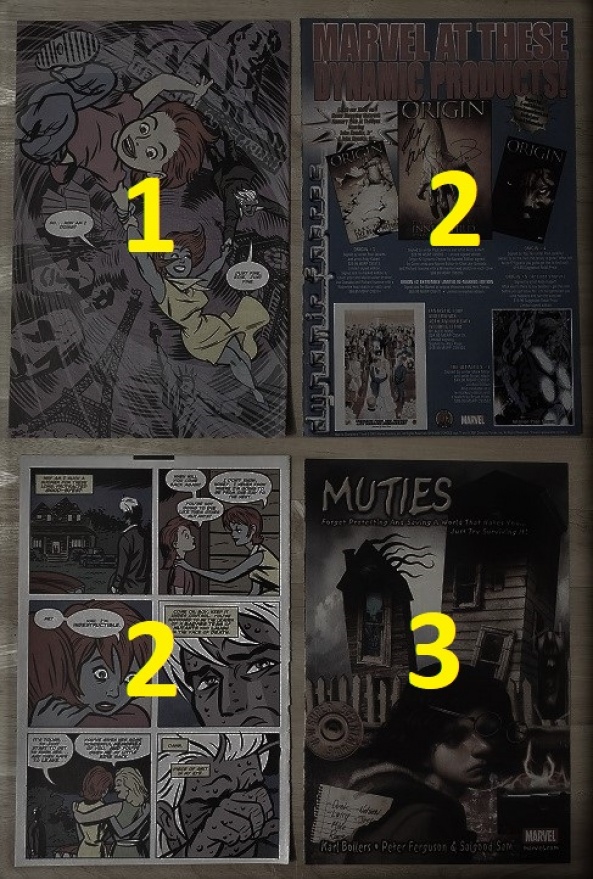
Since removing that second sheet isn’t an option, here’s how those four pages flow when you flip it over: what used to be story-ad-story-ad is now story-story-ad-ad.

Obviously, this trick only works if you don’t need to keep the sheet signature intact, so don’t count on this option if you’re making a Smythe-sewn bind.
How Do You Solve a Problem Like PARKER?
Cooke’s Parker work is tricky to include with other comics because its 6″x9″ trim size is much different than the standard 6.8″x10.25″ of modern comics. It’s not IMPOSSIBLE to just drop some pages of those books into a normal-sized bind, but you’d run into long-term structural issues alongside the aesthetic ones.
Situations like this call for a `copy-and-print’ or `scan-and-print’ approach, depending on your particular situation. In this case, you want that 6″x9″ page image on a sheet of paper 6.8″x10.25″ or larger at a usable size & quality to include in your book block. How do you do this? Copy/scan each page front and back with the comic page centered on the sheet, and have the output double-sided. This probably means cannibalizing a copy of the book to get single sheets to lay flat on the scanning screen. Make sure each page is scanned at no less than 300 dpi (dots per inch) or your output will be too small & sharp or too large & pixelated.
IDW’s standalone “The Man With The Getaway Face” release is actually well-suited for this treatment. At 24-pages saddle-stitched, scanning the pages should be easy without damaging the original comic. Its 8″x11″ trim-size means you’ll actually be sizing it down for inclusion instead of up, but the same rules apply.
And if the sticker price of outputting 24 color pages seems a little steep, Cooke’s monochromatic approach transfers over to black & white surprisingly well.

The Earth-2 Multiversity Edition
Paring down Cooke’s output into one book was a “fun” exercise, but given the chance I would just collect the man’s entire output. Fortunately, the concept of multiple dimensions and infinite earths means there’s at least one Earth that I did!
The best way to do this would be to take a cue from the music industry and put out both a comprehensive boxset as well as a highlights-only volume for the casual fan or those on limited funds.
Continued belowFirst, the highlights volume:
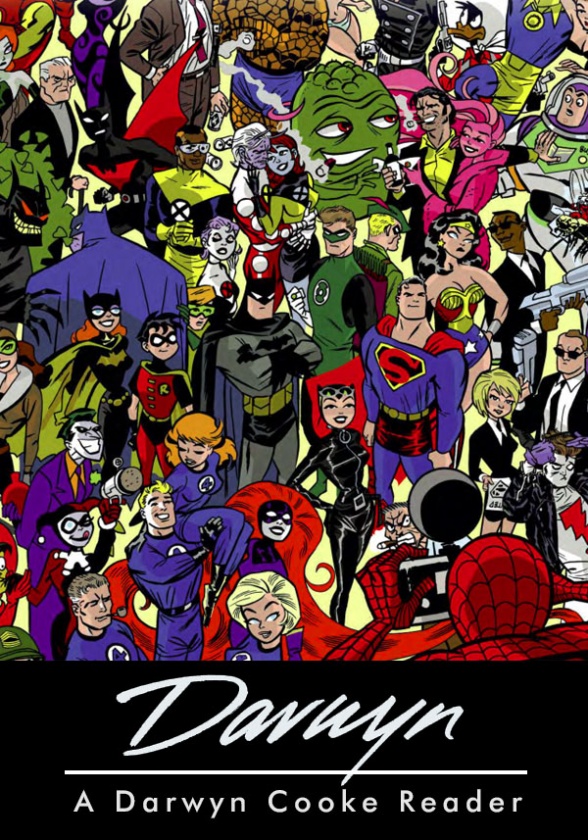
DARWYN: The Darwyn Cooke Reader
Written by: Darwyn Cooke, Peter Milligan, Ed Brubaker, Jimmy Palmiotti, Justin Gray, Donald E. Westlake,
Drawn by: Darwyn Cooke
Inked by: Darwyn Cooke, J. Bone, Mike Allred
Colored by: Darwyn Cooke, Dave Stewart, Laura Allred, Phil Noto
Lettered by: Darwyn Cooke, Jared K. Fletcher, Blambot, Rob LeighCover by: Darywn Cooke
Published by: DC Comics | Marvel Comics | Image Comics | IDW Publishing
Collecting:
- Solo #5
- Spider-Man’s Tangled Web #11
- Material from Detective Comics (v1) #759-762
- Selina’s Big Score OGN
- Catwoman (v3) #1
- X-Force (v1) #124
- Material from X-Statix #1
- Wolverine/Doop #1-2
- Before Watchmen #6
- The Spirit #1 & #8
- Material from Creator-Owned Heroes #6-8
- Material from DC: The New Frontier
- Parker: The Man With The Getaway Face
- Jonah Hex (v2) #33 & #50
- All-Star Western (v2) #34
Back Matter: Readers will gain access, via included DVD or QR codes, to the following:
- The Justice League: The New Frontier animated film, with optional Darwyn Cooke audio commentary track.
- “Retro Cool” video remembrance of Cooke’s life and career.
- Interviews:
- “Darwyn Cooke: New Frontiers“, Comic Book Artist (v2) #3, March 2004.
- “The Darwyn Cooke Interview“, The Comics Journal #285, October 2007.
- “Spotlight on Darwyn Cooke“, panel at WonderCon 2015.
- “Orbital in Conversation: Live from The Lakes with Darwyn Cooke“, podcast, November 2015.
- “Revengeance Revisited”, interview with editor Ron Richards about the unfinished creator-owned project.

And then, the complete six-volume set:
The Collected Darwyn Cooke
Vol. 1: Analog Heroes
- DC: The New Frontier #1-6
- Justice League: The New Frontier OS
- Before Watchmen: Minutemen #1-6
- Batman/The Spirit
- Will Eisner’s The Spirit #1-6, #8-12
Vol. 2: Bats and Cats and Spiders, Oh My!
- Batman: Ego OS
- Selina’s Big Score OGN
- Catwoman v3 #1-4
- Batman: Gotham Knights
- Trail of the Catwoman
- X-Force #124
- Material from X-Statix #1
- Wolverine/Doop #1-2
- Spider-Man’s Tangled Web #11,24
Vol. 3: Open All Day, All Night
- DC: The Art of Darwyn Cooke
- Before Watchmen: Silk Spectre #1-6
- Superman Confidential #1-5
- The Twilight Children #1-4
- Creator-Owned Heroes #6-8
Vol. 4: Richard Stark’s Parker, Part 1
- The Hunter
- The Man With The Getaway Face
- The Score
- The Seventh
Vol. 5: Richard Stark’s Parker, Part 2
- The Outfit
- Slayground
Vol. 6: Covers + Letters
- Cover Gallery
- Interviews:
- “Darwyn Cooke: New Frontiers“, Comic Book Artist (v2) #3, March 2004.
- “The Darwyn Cooke Interview“, The Comics Journal #285, October 2007.
- “Revengeance Revisited”, interview with editor Ron Richards about the unfinished creator-owned project.
Readers will gain access, via included DVD or QR codes, to the following:
- The Justice League: The New Frontier animated film, with optional Darwyn Cooke audio commentary track.
- “Retro Cool” video remembrance of Cooke’s life and career.
- “Spotlight on Darwyn Cooke“, panel at WonderCon 2015.
- “Orbital in Conversation: Live from The Lakes with Darwyn Cooke“, podcast, November 2015.
That’s All, Folks!
That’s it for this month’s column! Shelf Bound will be coming out the third Tuesday of every month from now on, meaning the next column will go up on December 17th.
I hope you’ve enjoyed what you’ve seen so far. While I have ideas for future binds and binding-related content, I really want to hear from you! Let me know what you thought of this bind! What did I get right! What did I get wrong! Give me some ideas about comics you think are shelf-worthy! Shoot me an email at greg@multiversitycomics.com or follow me on Twitter at @gregmatiasevich and let’s have some fun!






